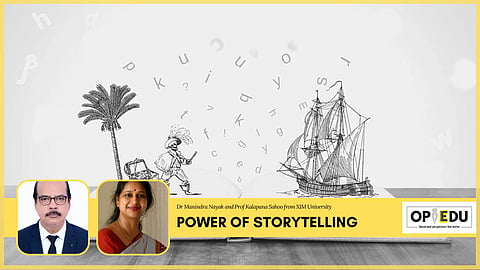

The impact of stories is most evident from Pandit Vishnu Sharma’s work, Panchantra. It is told that a king named Amarshakti had three sons. Unfortunately, all of them were foolish and irrational. The worried king was advised by his ministers to send his sons to Pt Bishnu Sharma for a turnaround. It is said that later, within a period of six months, the king’s sons became wise and judicious through their learning from stories told to them by Pt Vishnu Sharma. These fables are known as Panchantra (five chapters) with animals as character conveying moral lesson, were told nearly two thousand years ago but are still relevant and meaningful in the modern society and leaves a profound message on the reader.
Stories have always been an integral part of our existence and the glue that connects all humanity. The ability to listen to, comprehend and tell stories has a facilitative effect on cognitive processes and personal development for both children and adults. But we are staying in the world today which is very different. We find students do not want to spend time and energy doing anything which does not contribute directly to their examination scores.
Usually kids, including teenagers, have short attention spans. Further, reading books outside the school curriculum takes away from them playing games and it’s not as much fun as watching YouTube videos. Thus, students are wandering within their comfort zones, hardly contributing to broad-based learning.
But stories ignite the minds and take the children to a highly exciting world finally, leaving a meaningful message for all. Learning through stories sticks for a very long time. It is found that a good storyteller is a good communicator, a great teacher, a good manager and above all, can also be a great leader. Thus, to make students’ learning more interesting as well as for proper cognitive development, storytelling needs to find a place in a school curriculum
What can storytelling teach us?
Human beings are by nature storytellers. Even in ancient times, grandfathers and grandmothers usually shared stories with their grandchildren through their intelligence and imagination. Storytelling has long been a means of communication to build relationships and boost family bonding. It is a powerful tool for dispensing knowledge and promoting change.
This storytelling is the best medium to learn new concepts in a better way. The story is a type of narrative that is made with the imagination of the children. A healthy imagination developed in childhood is associated with problem-solving, openness to new ideas, ‘out of the box’ thinking and risk-taking – all valuable assets in life as an adult too. When creating and telling stories, children take on different roles and try out different language uses, all of which help them on the journey from being externally regulated to internally regulated in cognition.
Several studies have indicated that storytelling has a greater effect on child development due to its learning potential. Teachers and parents have an important role in ensuring that storytelling is a part of children’s daily lives. Nobel Laureate James J Heckman has pointed out that, “Chilhood skills shape our lives success – low-cost policies can truly strengthen these.”
NEP and storytelling
The National Education Policy (NEP) 2020 has emphasised the need for learning outcomes for competency-based teaching, learning and assessment at all stages of school education. It has become essential for educational institutions to launch the search for new forms and methods to generate more creativity in outcomes. So storytelling is an innovative communication tool, where students of any learning ability can try their best. Stories are about collaboration and connection. They transcend generations, they engage students through emotions, and they connect us to others.
Recommendations
Based on the above background, the following recommendations can be suggested:
- In the school curriculum, giving children the space to create and tell stories. The countries having the best schooling system in the world give paramount importance on this activity
- It is often sacrificed at the altar of reading and writing. Yet ironically, skills developed through storytelling and listening to stories also extend to enhance skills needed for effective reading and writing.
- Syllabus designers need to allocate time and give more emphasis to the storytelling technique when they design any text for language learning.
- It is an urgent need of our times. We can equip our children with 4Cs: Communication, Collaboration, Creativity, and Critical thinking, which are important for success. Children can enhance their emotional intelligence so that they would be more responsible for global citizens
- Training and development programmes for teachers can be initiated.
- There must be a platform where teachers can exchange their experiences with colleagues for effective teacher development to deal with student’s cognitive growth.
(Dr Manindra Nayak is a professor, retired from XIM University and is the founder of Odisha Storytelling Society, Bhubaneswar. Prof Kalapana Sahoo is an Associate Professor, XIM University, Bhubaneswar. The views expressed are authors' own)
